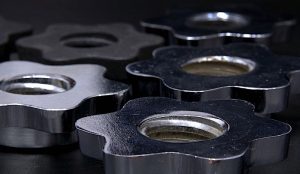 Better ways of degating die castings, according to Vibra Finish
Better ways of degating die castings, according to Vibra Finish
January 8, 2019 REDWIRE is news you can use from leading suppliers. Powered by FRASERS.
Posted by Vibra Finish Limited
Vibra Finish Limited is a manufacturer of vibratory finishing, centrifugal finishing, tumbling, separating, vibro-peenin... Read more
Subscribe
Free REDWIRE e-newsletter

Vibra Finish recommends several alternative methods for degating metal parts more efficiently.
Vibra Finish has amassed nearly half a century of expertise in metal-parts finishing. One area in which the company offers valuable advice to customers is degating and separating die castings. The typical degating method, apart from using trim dies, is tumbling parts in an open-mouth oblique barrel and then screen-separating them. But the moving/screening step takes excessive time, especially with dense loads of small pieces in large tumblers. The Vibra Finish team recommends alternative techniques.
Eliminating the moving step
One solution for more efficient degating and separating is modifying a horizontal barrel tumbler by adding an extra-large door opening. As the machine tumble-degates the load, it removes flash and polishes. Then the user replaces the solid door with a screen door, so the parts fall out during barrel rotation, leaving all the gates in the barrel. This method degates, deflashes, and separates the parts all at one station.
Another alternative technique is using an oblique tilting tumbler. The user adds locks to the mouth of the barrel to clamp on a screen door, then loads the barrel and puts the door in position. The barrel is run at a 45-degree upward tilt until it breaks off and smooths out the pieces, then is tilted down 45 degrees to bring the load forward to the screen. This method is perfect for users who have tilt tumblers, although horizontal barrels are quicker and more thorough.
Vibra Finish notes other factors that users should consider. First, it is unwise to add more fins for more aggressive action; although this shortens the cycle, it also can damage part surfaces severely and close up holes. Increasing the speed is the better choice. Additionally, the user must minimize the thickness of the sprue at the junction point when planning moulds. The best configuration is a smooth radius or taper, as opposed to a notch or step, and the parts should be cool and brittle to ensure a clean break. If flash is difficult to remove from fragile parts, run them in a screen basket in a sandblaster with glass shot.
To learn more, contact Vibra Finish.
Share
Posted by Vibra Finish Limited
Vibra Finish Limited is a manufacturer of vibratory finishing, centrifugal finishing, tumbling, separating, vibro-peenin... Read more